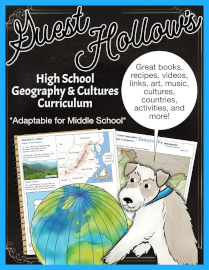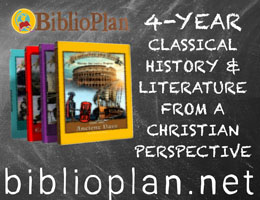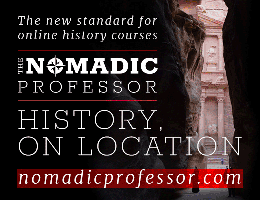Guest Hollow’s High School Geography and Cultures Curriculum is a 35-week course that can also be adapted for middle school students. The course has a unique design with a free online textbook that is used along with course materials that you purchase: a PDF workbook and a course schedule. You will also use a number of other books which you can buy or borrow, and you will probably want a globe and a world map.
Geography and cultures are the primary focus of the course, but it also has activities related to science (e.g., earth science, wildlife, and ecology), the fine arts, and language arts. If students read a sufficient number of the recommended fiction and non-fiction books, the course should also count as a part of a language-arts credit.
The Online Textbook
The online textbook, Guest Hollow’s High School Geography and Cultures Curriculum Online Textbook, is free because it is based on the book World Regional Geography by Caitlin Finlayson which is available for non-commercial sharing through a Creative Commons license. The course’s author, Jennifer Guest, has heavily edited the book to make it more suitable for her audience, and she has inserted many photos, maps, illustrations, and video links. Most of the videos can be watched on YouTube®. Some videos from TED-Ed are included, and these are followed by quizzes and discussion questions.
The Schedule
The online textbook serves as a spine book, the primary source of information. But the course schedule is the key for putting all of the course ingredients together. (You can use the schedule in either a PDF or a Microsoft Word format.) The schedule shows when to have students work in the online textbook, complete the workbook activities, do projects or cooking, complete the writing assignments, read supplemental books, etc. The schedule is loaded with links to books, Google Earth, free games at the Seterra website, art projects, recipes, and additional videos that are not linked in the textbook. The video recommendations include both full-length videos (some of which are not free) and brief videos on YouTube and other websites.
A free, online version of the schedule is included with your Guest Hollow membership, with two years of access. The online schedule is periodically updated. You can still use the downloaded course materials without the membership, and you can download a copy of the schedule that remains yours.
So many videos, books, and activities are included in the schedule that you almost certainly won’t have time to use all of them. While some resources are essential, many are optional, and you need to select those you think are most useful or interesting.
The recommended resources for the course are ranked #1 through #4, depending upon their importance. Those ranked #1 are considered essential and are written into the schedule, and some of those with lower rankings are also included in the schedule. You can enter other books you choose into the schedule yourself. However, questions are included in the course workbook for 16 of the recommended books, making it much easier to get the most benefit by using those particular books.
Examples of the #1 books required for this course are The Travel Book: A Journey Through Every Country in the World (Lonely Planet), Material World: A Global Family Portrait by Peter Menzel, Where on Earth? Atlas: The World As You’ve Never Seen it Before (DK), Hungry Planet – What the World Eats by Peter Menzel, and Prisoners of Geography by Tim Marshall. Most of these are used over many weeks, and you might want to purchase them. Most books ranked #2 through #4 are used for shorter periods of time and can be borrowed from the library. Examples of those ranked #2 are 50 Cities of the U.S.A.: Explore America’s Cities with 50 Fact-Filled Maps by Gabrielle Balkan, Foundations of Chinese Civilization (Understanding China Through Comics) by Jing Liu, The Girl with Seven Names: Escape from North Korea by Hyeonseo Lee, and God’s Smuggler by Brother Andrew.
The schedule includes cautions about the content of some of the resources and sometimes suggests alternatives, especially for younger students. Pages nine and ten in the schedule have specific instructions for adapting the course for use with a middle-school student.
The rest of the 130-page schedule consists of weekly lesson plans laid out on two or three pages per week in a chart format. They tell which pages to read in the online textbook and in some of the other books and which of the other resources you should use.
The recommended books cover a wide range of topics from geography, cultures, history, mythology, religion, travel, and cooking. The Religions Book (DK Books) is a #3 recommendation that might be used by all homeschoolers, and the schedule suggests But Don't All Religions Lead to God? as a supplement for Christian families. A few recommended books, such as Peace Child and God’s Smuggler, have Christian themes, while there are books supportive of other religious beliefs, such as The Book of Hindu Deities: From the Goddess of Wealth to the Sacred Cow and Ramayana: Divine Loophole.
The Workbook
The workbook is a major component of the course. It includes some instructional information with activities, map work, and questions, plus questions and activities based on many of the recommended resources. The answer key takes up the last third of the workbook. Cartoon characters—most frequently the dog Beowulf (see my review of Beowulf's Grammar)—appear throughout the workbook with silly interjections, so there’s a light-hearted feel to it that students will enjoy. A few reports and other writing assignments are included, but students will primarily be writing as they answer questions in the workbook.
Sample Lesson
I’ll use the Week 4 lesson material as an example of how this all works. First, students click on “1.7 Maps” in the online textbook. The textbook begins with information on latitude and longitude and various types of maps. Workbook activities reinforce this information. The online textbook continues with links to four videos, none of which runs longer than six minutes. (The last one consists of humorous man-on-the-street interviews that ask people to name any country on a map of the world. Most can’t name even one!) The online textbook section concludes with a list of key points to remember.
The schedule lists reading assignments from four non-fiction books. The workbook has questions and map work for one of those books, The Trivia Lover’s Guide to the World, chapters 17 to 33. The reading and workbook activities are spread out over five days.
No fiction or literature is listed for this week. Students are referred to a Seterra game on latitude and longitude and another YouTube video, “The Most Complex International Boundaries in the World, Part Three.”
Under the optional Extra Resources and Activities are links to two science experiments. Other optional activity suggestions for geography are practicing real-life navigation with a map of your local area, orienteering, or geocaching and to make a 3D topographic map. Website links to instructions are included for most activities. For art, the suggestion is to make a compass rose, and there are links for two options. Nine additional links are provided for brief videos related to geography and science, and there are two links to printable pages—one informational and the other a worksheet. In addition, three links to interactive, geography-related websites offer still more ways to learn. Finally, the last section of the schedule provides space for you to record titles and pages read from other books.
All of this looks like an intimidating amount of material. However, much of it is brief, some books and activities are optional, and everything is well organized to make it easy to find and use the resources.
Art and Music
Art or music activities (and sometimes both) are included each week. Music activities usually link to websites. For art, you will need some art supplies, such as air-drying clay, white gesso, watercolors, fabric paint, oil pastels, and a pysanka decorating kit. However, you should decide which activities you wish to use before purchasing all of the supplies since you might not want to do all of them. (See the project list on pages 24 through 30 of the schedule.) For those activities you choose to use, the instructions are generally found on linked websites.
Summary
I have reviewed a few other Guest Hollow courses that are similar in format to High School Geography and Cultures Curriculum. I really like their combination of multi-media and real books along with the workbook for accountability. The course isn’t as rigorous as many other geography courses for high school because it requires less memorization and mastery of vocabulary, but it is definitely more interesting.










